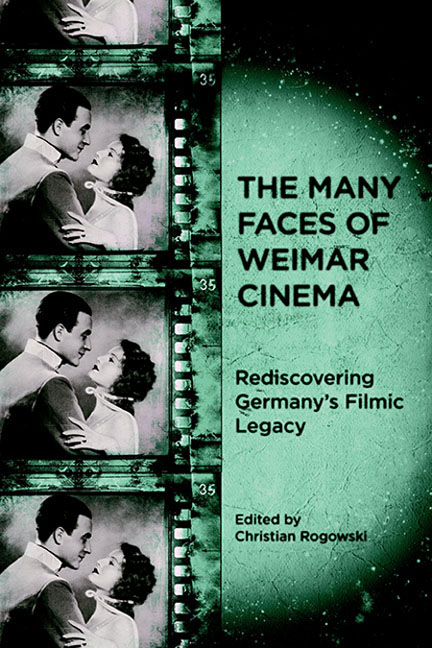Book contents
- Frontmatter
- Contents
- List of Illustrations
- Preface
- Introduction: Images and Imaginaries
- 1 Richard Oswald and the Social Hygiene Film: Promoting Public Health or Promiscuity?
- 2 Unsettling Nerves: Investigating War Trauma in Robert Reinert's Nerven (1919)
- 3 Humanity Unleashed: Anti-Bolshevism as Popular Culture in Early Weimar Cinema
- 4 Desire versus Despotism: The Politics of Sumurun (1920), Ernst Lubitsch's “Oriental” Fantasy
- 5 Romeo with Sidelocks: Jewish-Gentile Romance in E. A. Dupont's Das alte Gesetz (1923) and Other Early Weimar Assimilation Films
- 6 “These Hands Are Not My Hands”: War Trauma and Masculinity in Crisis in Robert Wiene's Orlacs Hände (1924)
- 7 The Star System in Weimar Cinema
- 8 Schaulust: Sexuality and Trauma in Conrad Veidt's Masculine Masquerades
- 9 The Musical Promise of Abstract Film
- 10 The International Project of National(ist) Film: Franz Osten in India
- 11 The Body in Time: Wilhelm Prager's Wege zu Kraft und Schönheit (1925)
- 12 Henrik Galeen's Alraune (1927): The Vamp and The Root of Horror
- 13 The Dialectic of (Sexual) Enlightenment: Wilhelm Dieterle's Geschlecht in Fesseln (1928)
- 14 Babel's Business — On Ufa's Multiple Language Film Versions, 1929–1933
- 15 “A New Era of Peace and Understanding”: The Integration of Sound Film into German Popular Cinema, 1929–1932
- 16 Landscapes of Death: Space and the Mobilization Genre in G. W. Pabst's Westfront 1918 (1930)
- 17 Undermining Babel: Victor Trivas's Niemandsland (1931)
- 18 Unmasking Brigitte Helm and Marlene Dietrich: The Vamp in German Romantic Comedies (1930–33)
- Filmography
- Notes on the Contributors
- Index
8 - Schaulust: Sexuality and Trauma in Conrad Veidt's Masculine Masquerades
Published online by Cambridge University Press: 29 April 2017
- Frontmatter
- Contents
- List of Illustrations
- Preface
- Introduction: Images and Imaginaries
- 1 Richard Oswald and the Social Hygiene Film: Promoting Public Health or Promiscuity?
- 2 Unsettling Nerves: Investigating War Trauma in Robert Reinert's Nerven (1919)
- 3 Humanity Unleashed: Anti-Bolshevism as Popular Culture in Early Weimar Cinema
- 4 Desire versus Despotism: The Politics of Sumurun (1920), Ernst Lubitsch's “Oriental” Fantasy
- 5 Romeo with Sidelocks: Jewish-Gentile Romance in E. A. Dupont's Das alte Gesetz (1923) and Other Early Weimar Assimilation Films
- 6 “These Hands Are Not My Hands”: War Trauma and Masculinity in Crisis in Robert Wiene's Orlacs Hände (1924)
- 7 The Star System in Weimar Cinema
- 8 Schaulust: Sexuality and Trauma in Conrad Veidt's Masculine Masquerades
- 9 The Musical Promise of Abstract Film
- 10 The International Project of National(ist) Film: Franz Osten in India
- 11 The Body in Time: Wilhelm Prager's Wege zu Kraft und Schönheit (1925)
- 12 Henrik Galeen's Alraune (1927): The Vamp and The Root of Horror
- 13 The Dialectic of (Sexual) Enlightenment: Wilhelm Dieterle's Geschlecht in Fesseln (1928)
- 14 Babel's Business — On Ufa's Multiple Language Film Versions, 1929–1933
- 15 “A New Era of Peace and Understanding”: The Integration of Sound Film into German Popular Cinema, 1929–1932
- 16 Landscapes of Death: Space and the Mobilization Genre in G. W. Pabst's Westfront 1918 (1930)
- 17 Undermining Babel: Victor Trivas's Niemandsland (1931)
- 18 Unmasking Brigitte Helm and Marlene Dietrich: The Vamp in German Romantic Comedies (1930–33)
- Filmography
- Notes on the Contributors
- Index
Summary
Something apparently in between star and character type. The adoring young girls want to see him as a star; a certain type of mature woman as the above mentioned something in between; but we only want to see him as a character type, for that's where the slim, sinewy ascetic is totally at home. He is the personified spirit of the third dimension, thus the fourth dimension. When he wants to, his eyes look into the fourth realm, his visage becomes transparent and seems as if it has been eaten away by all his passions. His dark soul is visible on his face! And then he even plays upon this soul, as if it were a tortured, screeching violin. He is an indispensable enrichment, a type all his own!
— Heinz Salmon, “Charaktertyp” 1919
Contemporary commentators rhapsodized about Conrad Veidt's unusual appeal to his public, and Erika and Klaus Mann would later write that almost no actor was as popular as Veidt in interwar Germany (95). As we see in the above quotation, as early as 1919 film critic Heinz Salmon emphasized Veidt's multiple attractions for his fans, who saw him as a standard love object, as spiritual and an artist, and as an otherworldly ascetic. Writing three years later, critic Fritz Scharf discussed Veidt as a cultural phenomenon with wide-reaching influence: “Damsels from ages eight through eighty who are even mildly infected by the hysteria have each made HIM an altar in their more or less roomy bosoms; for pale looking lads, HE is their life's goal personified” (43).
In Hinter den Kulissen (Behind the Scenes), a 1927 photomontage by Bauhaus artist Marianne Brandt, Conrad Veidt's face emerges out of an inky darkness to nuzzle the head of a dreaming New Woman (fig. 8.1). Veidt seems both alluring and — with his gaunt features, sleepy eyes, and almost leering smile — somehow sinister. He presents a stark contrast to his pendant figure on the New Woman's right, Douglas Fairbanks as a grinning allegory of Hollywood's superficial appeal. Veidt's face is served up on a crescent-moon strip of white to frame it as a figment of the New Woman's imagination and the subject of her fantasy.
- Type
- Chapter
- Information
- The Many Faces of Weimar CinemaRediscovering Germany's Filmic Legacy, pp. 134 - 152Publisher: Boydell & BrewerPrint publication year: 2010

